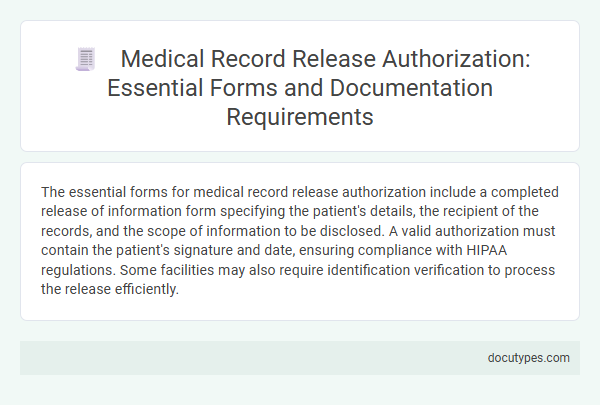The essential forms for medical record release authorization include a completed release of information form specifying the patient's details, the recipient of the records, and the scope of information to be disclosed. A valid authorization must contain the patient's signature and date, ensuring compliance with HIPAA regulations. Some facilities may also require identification verification to process the release efficiently.
Introduction to Medical Record Release Authorization
Medical record release authorization is a crucial process that allows healthcare providers to share your medical information with authorized parties. This authorization ensures the privacy and security of your sensitive health data while enabling continuity of care.
The essential forms for medical record release authorization include a detailed consent form specifying the recipient, type of information to be shared, and purpose of release. These forms must comply with HIPAA regulations to protect your rights and maintain confidentiality. Proper completion of these documents helps avoid delays and legal issues in accessing medical records.
Importance of Medical Record Release in Healthcare
Medical record release authorization is crucial for ensuring secure and accurate sharing of your health information between providers. Proper authorization forms protect patient privacy while enabling effective healthcare coordination.
- Authorization Form - This document grants permission to release specific medical records to designated individuals or organizations.
- HIPAA Release Form - Complies with federal privacy laws and outlines the extent of information disclosure allowed.
- Consent for Disclosure - Clarifies the purpose and scope of records shared, ensuring patient control over sensitive data.
Key Components of Authorization Forms
Medical record release authorization forms are crucial for protecting patient privacy and ensuring proper consent. Key components include the patient's details, specific records to be released, and the recipient's information.
The form must clearly state the purpose of the release and the expiration date of the authorization. A valid signature and date from the patient or legal guardian are essential to complete the authorization process.
Legal and Regulatory Compliance Requirements
| Form Name | Purpose | Key Legal and Regulatory Compliance Requirements |
|---|---|---|
| HIPAA Authorization Form | Obtains patient consent to release protected health information (PHI) | Must comply with Health Insurance Portability and Accountability Act (HIPAA) Privacy Rule, include specific description of information to be disclosed, expiration date, and patient signature |
| Release of Information (ROI) Form | Authorizes healthcare providers to share medical records with designated parties | Should detail recipient information, purpose of release, and adhere to state-specific privacy laws |
| Consent for Release of Mental Health Records | Permits disclosure of sensitive mental health information | Complies with 42 CFR Part 2 regulations and applicable state laws, requires explicit patient consent and often additional safeguards |
| Authorization for Release of Substance Abuse Treatment Records | Allows sharing of substance abuse treatment information | Regulated under 42 CFR Part 2, mandating strict confidentiality, with specific consent language and limitations on redisclosure |
| General Medical Record Release Form | Facilitates transfer of general medical information for continuity of care | Must include patient identification, description of information, purpose, expiration, and comply with HIPAA and state privacy laws |
Required Patient Information and Identification
Which forms are essential for medical record release authorization? The primary form required is the Medical Record Release Authorization Form, which must include detailed patient information. This form ensures accurate identification and proper handling of medical data.
What patient information is required on the medical record release authorization form? Key details include the patient's full name, date of birth, and contact information. These identifiers verify the patient's identity and authorize the release of sensitive health records.
Why is patient identification critical in medical record release? Accurate identification prevents unauthorized access to medical information and protects patient privacy. Forms typically require a valid government-issued ID number or health insurance details for verification.
Types of Medical Records Covered by Release
Medical record release authorization requires specific forms to ensure proper handling and confidentiality. These forms cover various types of medical records, including treatment histories, diagnostic reports, and medication lists.
Your authorization typically encompasses records from hospitals, clinics, mental health providers, and laboratories. It is essential to specify the exact types of records you want released to avoid delays and protect your privacy.
Steps to Complete Medical Record Release Forms
Medical record release authorization requires specific forms to ensure patient privacy and legal compliance. Essential forms include the HIPAA Release Form, which details the information to be shared, and the Medical Record Release Authorization Form, outlining the authorized recipients. Completing these forms involves verifying patient identity, specifying the records requested, and obtaining a signature to authorize disclosure.
Common Documentation Errors to Avoid
Medical record release authorization requires precise forms to ensure proper access and confidentiality. Avoiding common documentation errors can prevent delays and legal issues.
- Incomplete Authorization Form - Missing signatures or dates can invalidate the release request, causing processing delays.
- Incorrect Patient Information - Errors in name, date of birth, or medical record number can result in records being inaccessible or sent to the wrong party.
- Unclear Scope of Release - Failing to specify the exact records or time frame needed may lead to overbroad or insufficient disclosures, violating privacy regulations.
Revoking or Amending Authorization
The essential forms for medical record release authorization include the Authorization to Release Medical Records and the Consent to Release Protected Health Information. These forms must clearly state the patient's information, the recipient of the records, and the specific data to be disclosed. To revoke or amend authorization, you need to submit a written request using a Revocation of Authorization form or an updated release form, ensuring your medical records remain accurate and your privacy preferences are respected.
Which Forms Are Essential for Medical Record Release Authorization? Infographic

